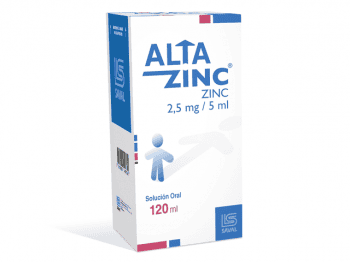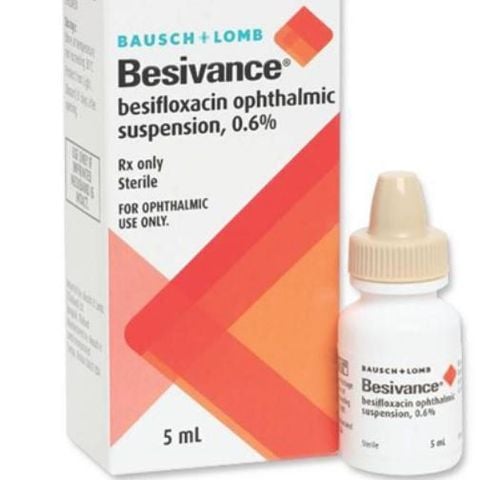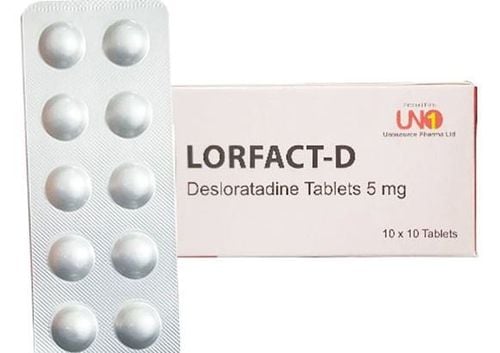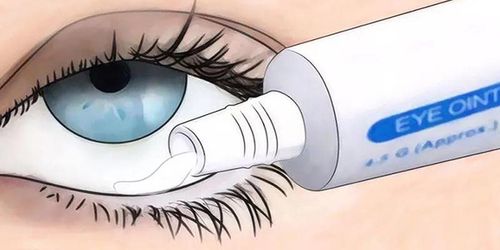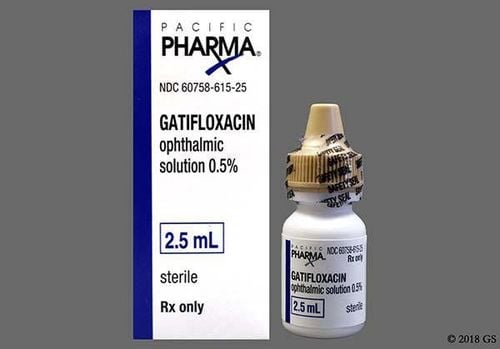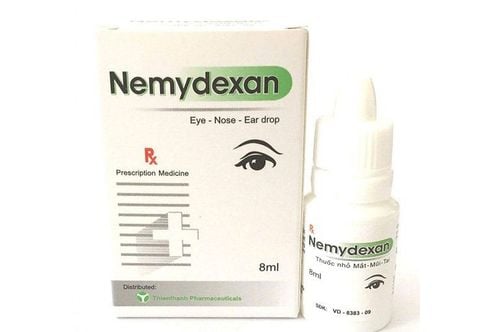This is an automatically translated article.
Conjunctivitis is a common facial disease not only in adults but also in children. The causes of conjunctivitis are usually viruses and bacteria. Although the disease is not serious, but if the child is not cared for properly, it can make the progression worse and the risk of affecting the child's vision later on. Therefore, parents of children need to have the right and safe ways to care for their children.1. What is pink eye (conjunctivitis)?
Pink eye, or conjunctivitis, is a very common and treatable conjunctivitis. The conjunctiva is a mucous membrane that covers the surface of the eye, runs from the edge of the cornea to the free edge of the back of the eyelid, and folds at the same margin. The conjunctiva is made up of an epithelial layer that is connected to the parenchyma by a basement membrane. The base is a non-keratinized stratified squamous epithelium, containing goblet cells (monocytic mucinous glands) and other glandular structures, such as accessory lacrimal glands.The conjunctival parenchyma contains a lymphatic network with lymphocytes, mast cells, and macrophages, along with a dense network of blood vessels. Blood vessels become more visible when the conjunctiva becomes inflamed, giving the eye a pink or red color characteristic of this condition.
Inflammation can be caused by an infection, an allergen or some other irritant. Pink eye is caused by bacteria and viruses, so they are very contagious.
2. Symptoms of pink eye in babies
Inflammation of the whites of the eyes and the lower rim of the eyelids. Increased discharge in the eyes Swelling of the eyelids or eyelashes. The most obvious manifestation of pinkeye is a watery eye and the whites of the eyes gradually turn red. The baby will have a feeling of discomfort and discomfort, so it is often fussy, when waking up, the gel often sticks to the eyelids. Alum can be yellow or green.Some cases of conjunctivitis with pseudoconjunctivitis (the clear white membrane under the eyelids) take longer to heal than others. When sick, children also often have symptoms such as low-grade fever, dry cough, lymphadenopathy...
Although pink eye usually resolves after 7-10 days, if not cared for and treated appropriately, the disease can cause illness. can progress more seriously and leave many dangerous complications such as trachoma, chronic conjunctivitis, corneal ulcers, corneal scarring, vision loss, blindness...
Call your baby's doctor as soon as you notice the symptoms of pink eye. It's important to get treatment promptly, to avoid spreading germs and to prevent serious complications like infection of the eyelids and soft tissue around the eyes. However, these conditions are rare
Occasionally, mild redness and swelling of the eyelids in infants can be a type of conjunctivitis caused by a reaction to the infant eye drops. This situation will go away quickly after a short time.
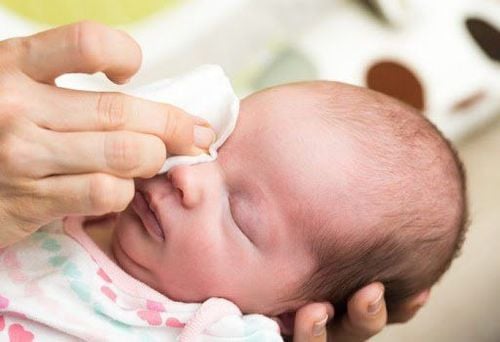
Đôi khi, tình trạng mắt đỏ nhẹ và sưng mí mắt ở trẻ sơ sinh có thể là một loại viêm kết mạc do phản ứng với thuốc nhỏ mắt cho trẻ sơ sinh
3. Causes of eye conjunctivitis
Here are some common causes of conjunctivitis:Viral: If your baby has conjunctivitis as well as accompanying cold symptoms, the infection is most likely caused by a virus. Viruses are the most common cause of conjunctivitis in both children and adults. Bacteria: If your baby's eyes have a thick yellow discharge that causes the eyelids to swell or stick together, it's probably caused by bacteria like staphylococcus, streptococcus, or haemophilus. There is also a serious form of bacterial conjunctivitis called neonatal eye disease, which occurs in infants exposed to chlamydia or gonorrhea during vaginal delivery. Allergens: Allergic reactions are rare in infants younger than 1 year, but if your baby's eyes appear itchy and swollen as well as watery and bloodshot and he has a runny nose, he may have a cold. allergies to irritants such as dust, pollen, or smoking. Newborn eye drops: Newborn eye drops to prevent bacterial infections that can irritate an infant's eyes. This is also sometimes called chemical conjunctivitis. Blocked tear ducts: At least 20 percent of children are born with one or both blocked or partially blocked tear ducts. The blockage can lead to conjunctivitis-like symptoms, such as white or yellow discharge, or fulminant conjunctivitis. Other irritants: Anything that can irritate the eyes and eyelids, from smog to chlorine in swimming pools.
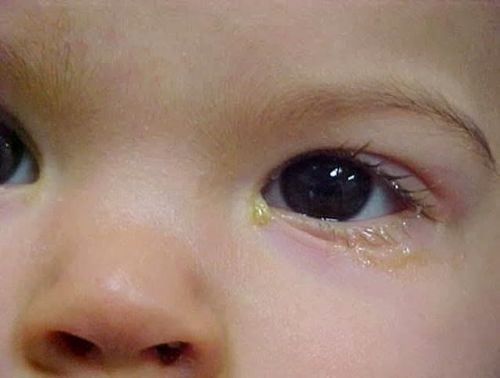
Ít nhất 20 phần trăm trẻ em được sinh ra với một hoặc cả hai ống dẫn nước mắt bị tắc hoặc tắc một phần
4. How to treat pink eye?
If your newborn has pink eye, call your doctor right away. It can be a serious infection in infants. The doctor will examine your baby's eyes and ask about your baby's symptoms. Treatment will depend on the type of pink eye:4.1.Viral conjunctivitis. Conjunctivitis is caused by a virus. Symptoms usually go away on their own after a week or so.
Your doctor will advise you to keep the eye area clean by gently rinsing your child's eyes with warm water and drying the discharge. If your baby's eyes don't improve after two weeks, call the doctor for a checkup.
When cleaning the child's eye area, you can use a warm compress and gently clean and wipe the discharge in the child's eye area. If your baby is uncomfortable, you can also use a clean gauze soaked in warm water and place it over your baby's eyes (e.g. while he's nursing) which can help ease the discomfort.
4.2. Bacterial conjunctivitis If bacteria is the cause of your conjunctivitis, your doctor will prescribe antibiotic ointments or drops for you to keep in your baby's eyes for about seven days.
You may find ointments easier to apply than eye drops: Wash your hands, then gently pull your baby's lower eyelid down a little and squeeze to let the ointment get into your baby's eyes. (The ointment falls out of the tube when you squeeze, so you just need to adjust it to get it right into your baby's eye.) When your baby blinks, the ointment will go into her eye.
If you are using eye drops, aim at the inner corner of your baby's eye. This may be easiest to do with the child's eyes closed. When a child opens his or her eyes, the medicine will enter the conjunctiva of the child's eye.
Wash your hands before and after treating your baby's eyes. Never share medications or use old drops or ointments. Older medicines are likely not sterile and can make an infection worse.
Make sure you take the full course of antibiotics, even if the symptoms are gone. Otherwise, the infection may return.
Your doctor will probably recommend rinsing your child's eyes with warm water and gently rubbing the dried discharge because a buildup of infected fluid can make the antibiotics less effective.
A warm compress can help the child feel more comfortable. Dip a clean cloth in warm water and place it over your baby's eyes.

Đảm bảo bạn sử dụng kháng sinh đầy đủ, theo đúng liệu trình, ngay cả khi các triệu chứng đã hết
If your baby's eyes are bothering him, a cool compress can help ease allergic conjunctivitis.
4.4. Chemical conjunctivitis This reaction to infant eye drops used to prevent infection is likely to last only 24 to 36 hours.
Parents need to provide enough nutrition for their children so that the child has enough resistance to the disease, not being exhausted in health, making the disease last longer. Children also need to rest, isolate, take medicine according to the doctor's prescription.
Parents should not arbitrarily buy eye drops, use other people's eye drops for their children without consulting a doctor because each patient may be suitable for different drugs. very long time.
5. How is pink eye contagious?
In addition, children often have a habit of rubbing their eyes. When they come into contact with unsanitary objects, then they rub their eyes with their hands, which is also very easy to cause red eyes. If a baby comes into contact with or plays with other children with pink eye, the possibility of infection is also very high. Therefore, parents must regularly pay attention to clean hands and feet for children.Pinkeye can be spread through:
Direct contact with an infected person. Touching the patient's objects such as door handles, tables and chairs. Sharing personal items with the sick person such as towels, pillows, washbasins. Sharing contaminated water. Sharing water with an infected person, such as in a swimming pool. Or rub your eyes. Crowded places such as hospitals, public places, and schools are easy environments for disease to spread. Bacterial and viral conjunctivitis are both highly contagious. To prevent the infection from spreading, wash your hands every time you're done caring for your baby's eyes. Keep your baby's towels, clothes, and bedding separate from others and wash them often.

Khi tiếp xúc với đồ vật không đảm bảo vệ sinh, sau đó trẻ đưa tay dụi mắt cũng rất dễ khiến bé bị đau mắt đỏ
6. Can my child with pink eye go to daycare?
Children who are sick should stay away from school, school or crowded places during their illness to avoid spreading the illness to others. Children should also not hug, kiss or kiss others because of pink eye disease through the respiratory tract, tears, saliva, handshakes, especially the tears of the sick person, which contain a lot of viruses...You will must check the child care center's policy to find out if your child can attend while having symptoms. The American Academy of Pediatrics suggests that it's not always necessary for children to stay home because of pink eye, but institutions have their own rules. For example, some allow children to return after 24 hours of treatment. Others don't let the child come back until the child has no more eye discharge.
Pink eye is not a serious disease, it can go away on its own after about a week if it is treated properly. However, there are cases where serious eye-related complications or long-term discomfort can occur. Therefore, in addition to complying with what to do and what to abstain from pink eye, patients should go to medical facilities with eye specialists for timely examination and treatment.
As a key area of Vinmec Health system, Pediatrics Department always brings satisfaction to customers and is highly appreciated by industry experts with:
Gathering a team of top doctors and nurses in Pediatrics : consists of leading experts with high professional qualifications (professors, associate professors, doctorates, masters), experienced, worked at major hospitals such as Bach Mai, 108.. Doctors All doctors are well-trained, professional, conscientious and knowledgeable about young psychology. In addition to domestic pediatric specialists, the Department of Pediatrics also has the participation of foreign experts (Japan, Singapore, Australia, USA) who are always pioneers in applying the latest and most effective treatment regimens. . Comprehensive services: In the field of Pediatrics, Vinmec provides a series of continuous medical examination and treatment services from Newborn to Pediatric and Vaccine,... according to international standards to help parents take care of their baby's health from birth to childhood. from birth to adulthood Specialized techniques: Vinmec has successfully deployed many specialized techniques to make the treatment of difficult diseases in Pediatrics more effective: neurosurgery - skull surgery, stem cell transplantation. blood in cancer treatment. Professional care: In addition to understanding children's psychology, Vinmec also pays special attention to the children's play space, helping them to have fun and get used to the hospital's environment, cooperate in treatment, improve the efficiency of medical treatment.
Please dial HOTLINE for more information or register for an appointment HERE. Download MyVinmec app to make appointments faster and to manage your bookings easily.
Reference source: babycenter.com



